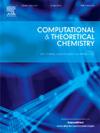硫化镓纳米片检测和吸附O2和H2O的可能性:DFT和热力学观点
IF 3
3区 化学
Q3 CHEMISTRY, PHYSICAL
引用次数: 0
摘要
本研究报告了原始和氢化硫化镓纳米片(GaS-NF)臂型(AC)和之字形(ZZ)构型的环境氧和水相互作用驱动的电子和热力学性质。氢化增加了硫化镓纳米片(尤其是之字形(ZZ)构型)与分子之间的相互作用,表明氢化纳米片的电子敏感性增强。ZZ构型,尤其是氢化状态下的ZZ构型,显示出与O2的明显反应性,并保持物理吸附,这从态密度分析中出现的一个突出的O(2p)峰可以得到证明。氧相互作用使之字形原始纳米片和氢化纳米片的量子电容值分别增加到 250 μF/cm2 和 200 μF/cm2。扫描隧道显微镜(STM)显示,边缘的电子定位更为明显。热力学分析表明,在低温低压条件下,O2 和 H2O 的吸附几率都很高,ZZ 配置适合氧气检测,AC 配置适合湿度传感和水过滤应用。本文章由计算机程序翻译,如有差异,请以英文原文为准。

Possibility of gallium sulfide nanoflakes for detection and adsorption of O2 and H2O: A DFT and thermodynamic perspective
In this study, environmental oxygen and water interaction-driven electronic and thermodynamic properties of pristine and hydrogenated gallium sulfide nanoflakes (GaS-NF) in armchair (AC) and zigzag (ZZ) configurations have been reported. The hydrogenation increases the interaction between GaS nanoflakes, particularly in the zigzag (ZZ) configuration, and the molecules, suggesting enhanced electronic sensitivity in hydrogenated nanoflakes. The ZZ configuration, particularly in the hydrogenated state, shows pronounced reactivity with O2, maintaining physisorption, as evidenced by the appearance of a prominent O(2p) peak in the density of states analysis. The oxygen interaction increases the quantum capacitance value up to 250 μF/cm2 and 200 μF/cm2 in zigzag pristine and hydrogenated nanoflake, respectively. Scanning tunneling microscopy (STM) reveals more pronounced electronic localization at the edges. Thermodynamic analysis indicates high adsorption probabilities for both O2 and H2O at low temperatures and pressures, with the ZZ configuration being suitable for oxygen detection and the AC configuration for humidity sensing and water filtration applications.
求助全文
通过发布文献求助,成功后即可免费获取论文全文。
去求助
来源期刊

Computational and Theoretical Chemistry
CHEMISTRY, PHYSICAL-
CiteScore
4.20
自引率
10.70%
发文量
331
审稿时长
31 days
期刊介绍:
Computational and Theoretical Chemistry publishes high quality, original reports of significance in computational and theoretical chemistry including those that deal with problems of structure, properties, energetics, weak interactions, reaction mechanisms, catalysis, and reaction rates involving atoms, molecules, clusters, surfaces, and bulk matter.
 求助内容:
求助内容: 应助结果提醒方式:
应助结果提醒方式:


